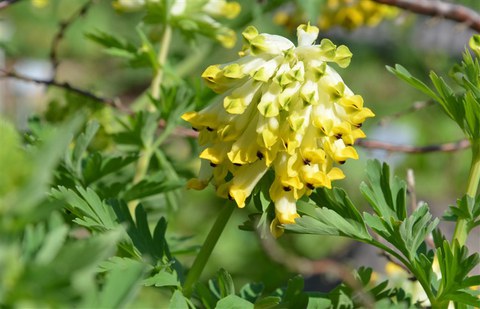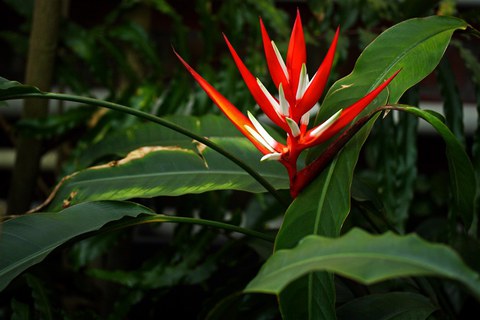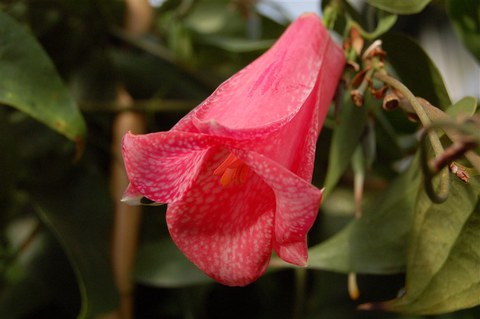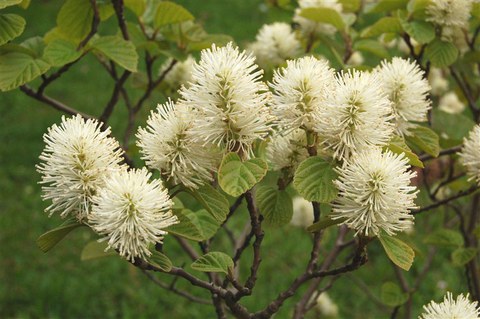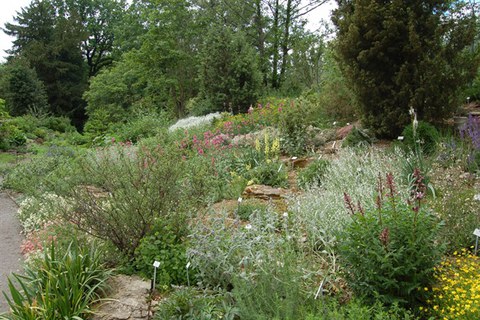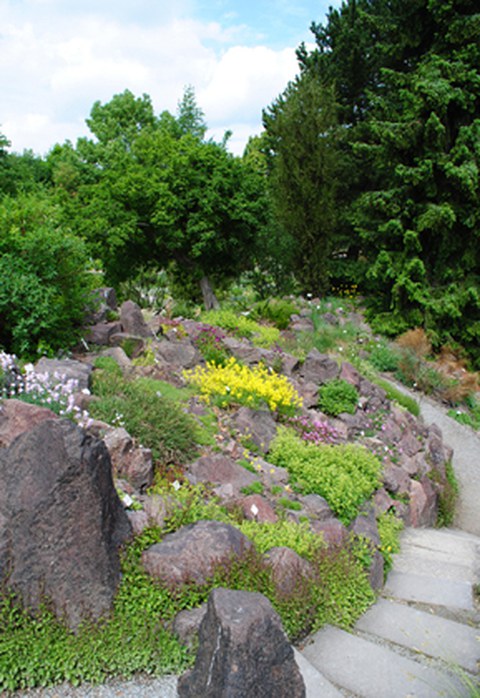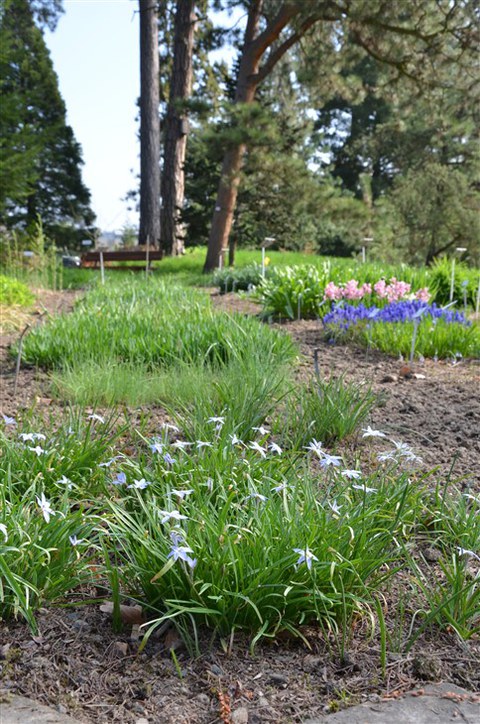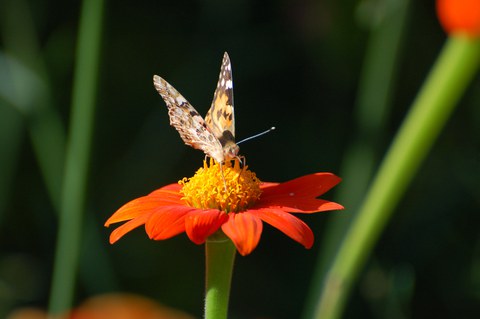A tour through the Botanical Garden
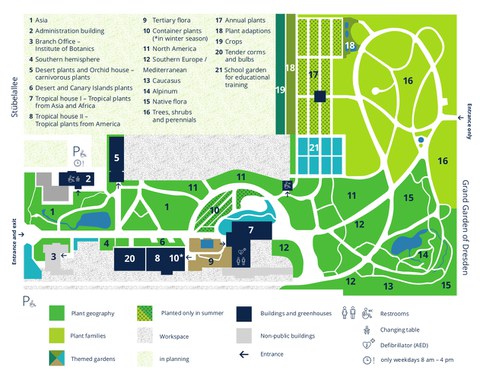
Map of the Botanical Garden
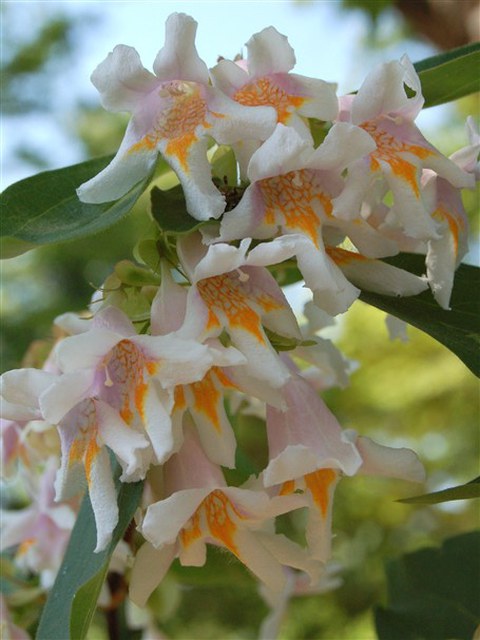
Dipelta floribunda
On the left side as you come in through the main entrance is the outdoor Asian plant garden (1). Depending on the season, woody plants like Witch Hazel (Hamamelismollis and H. japonica), Magnolias, Dipelta floribunda, Rhododendrons or wild roses are flowering. On of the latest to bloom is Heptacodium miconioides in September. Some trees, like Phellodendron amurense and Ginkgo biloba, or shrubs, like Magnolia stellata and Platycrater arguta, are among the oldest of the garden.
In spring, blankets of yellow flowering Siberian Corydalis (Corydalis nobilis) cover the ground with blue-green foliage, later to be followed by 6 foot high inflorescences of the Steppe Candle (Eremurus), Feather Grass (Stipa) and Goat’s Beard (Aruncus aethusifolius).
Some flower beds on the right are followed by an area with hardy plants from the Southern hemisphere (4). Most are low growing plants and ground covers from temperate South America or New Zealand. Among the larger plants are the Southern Beech (Nothofagus antarctica) and the perennial Gunnera manicata with its large Rhubarb shaped leaves.
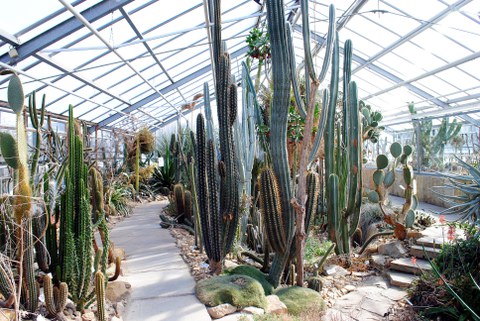
Succulent collection
Plants from tropical and subtropical arid regions can be seen in the outdoor garden for desert and Canary Islands plants (6, partially protected from frost in winter) and in the desert plant house (5). By means of their thick, fleshy water storage tissue some of them may survive even years of drought. Cactus and agave plants dominate the succulent flora of the American deserts while Euphorbia and Aloe are characteristic succulent genera in arid environments of Africa and Madagascar. Species from the Canary Islands (like Aeonium) are represented as well. In a showcase located in the lobby of the desert plant house (5), blooming orchids and a variety of carnivorous plants are displayed.
During the summer months the Tropical house II (8) gives room to plants from tropical America, including the cocoa tree (Theobroma cacao) and pineapple (Ananas comosus). High above the ground on gnarled branches the leaf cisterns - epiphytic bromeliads - are growing. Long beards of the Louisiana Moss (Tillandsia usneoides) hang down from above - it is also a bromeliad. Tiny silvery water absorbing squamiform scales on leaves and stems provide the rootless plant with moisture. In the back of the house, from January to March, a native of Brazil, Heliconia angusta, blooms. The Victoria water lily (Victoria amazonica), namesake of the show house, is sown annually and can be seen from mid May in the water basin in the greenhouse. In late summer the edged floating leaves reach up to 2 m in diameter and bear the weight of a person. Its flowers open at night. In the cold season the empty lily pond is used to overwinter container plants: trees and shrubs from subtropical and Mediterranean regions.
The Tertiary section (9) shows nearest relatives to plants, which grew about 65 million years ago in the lignite forests of Saxony. Some of them are still part of the local flora. Others, such as sweetbay (Magnolia virginiana), baldcypress (Taxodium distichum), tupelo (Nyssa sylvatica) and wheel wingnut (Cyclocarya paliurus), became extinct in Central Europe as a result of climate change during the glacial period, but survived in America or East Asia.
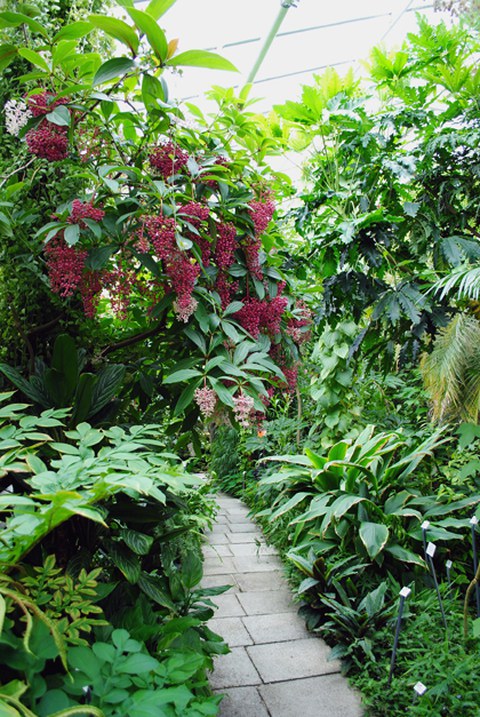
Tropical Conservatory
The Tropical house I (7) is dedicated to the continents of Africa and Asia. Coffee plants (Coffea arabica), sugarcane (Saccharum officinarum), banana plants (Musa acuminata), pepper (Piper nigrum), cinnamon (Cinnamomum verum) and cotton (Gossypium arboreum) as well as African violets (Saintpaulia), flame lily (Gloriosa superba) and the colourful flowers of Impatiens niamniamensis are awaiting visitors. There are a lot of interesting features to be discovered such as huge staghorn ferns (Platycerium) in the treetops, a mighty screwpine (Pandanus utilis) and the Indian Sacred Fig tree (Ficus religiosa) Aquariums and a large display tank in the right wing of the house contains tropical aquatic plants.
Around mid-May, the container plants (10) - sorted by areas of origin – are placed in front of the Tropical house I. Among them are representatives of Mediterranean flora, such as the olive tree (Olea europaea), the pomegranate (Punica granatum), the laurel (Laurus nobilis) or the cork-oak (Quercus suber). Others are of South African origin, like blue plumbago (Plumbago auriculata), or naturally grow in the Americas, like Fuchsias or copihue, the splendid national flower of Chile (Lapageria rosea).
Notable trees in the outdoor section of North American plants (11) include the willow oak (Quercus phellos): its leaves hardly resemble oak leaves but you have to look at the fruit to reveal the relationship. During May/June the dogwood (Cornus florida) is in full bloom and an attraction for all visitors. Flowering witch alder (Fothergilla major) is less conspicuous but all its leaves turn bright red in autumn. Jacobs ladder (Polemonium), shooting star (Dodecatheon), penstemon (Penstemon) and other perrenials grow on the hills between the trees and bushes.
Hardy species from the Mediterranean region are presented in the Mediterranean garden (12). Here in the early spring, the Christmas roses (Helleborus) and wild crocuses (Crocus) show their flowers. They bloom before the daffodils (Narcissus), tulips (Tulipa) and peonies (Paeonia). Later the shrubs and bushes are attracting the pollinators with their blossoms: mint family plants such as sage (Salvia), thyme (Thymus), Jerusalem sage (Phlomis), lavender (Lavendula) and others. In September near the end of the growing season, the flowers of the meadow saffron (Colchicum) can be admired.
In the Alpine garden (14) a selection of European montane plants is growing, including gentians (Gentiana), saxifrage species (Saxifraga), many crucifers, members of the carnation family and primroses. Every mountain range between the Pyrenees and the Caucasus has its own characteristic flora. Cushion plants are numerous. They are especially well adapted to alpine conditions, as they survive the long and cold mountain winter sheltered by the the snow. Woody plants such as alpenrose (Rhododendron hirsutum and R. ferrugineum), arolla pine (Pinus cembra) and Serbian spruce (Picea omorica) are scattered throughout. In small bogs, cotton grass (Eriophorum), butterwort (Pinguicula) and sundew (Drosera) are growing.
Besides plants from foreign lands, native wild plants from Saxony and Thuringia (15) can be found. In a small area, one finds forest vegetation, water and reed plants, plants growing in open, rocky or sandy habitats or meadows. People taking a Sunday stroll in the countryside who encounter unusual species can come here to search for the name of the plants. But beware, native plants can also be found elsewhere in the garden, for example, in the area of marsh and aquatic plants (18), and not all of our native plants have been added to the inventory of the garden.
Species with characteristic similarities can be grouped into plant families. The Plant Family Section (16) introduces such botanically related groups. Ipheion uniflorum is a monocot species closely related to onion and garlic. Aster family and orchids are the two families with the most species worldwide – about 25,000 species each. The scientific name of the family can be seen by the ending “-aceae”. It is always derived of the name of a genus in that particular family, (e.g. “Ranunculaceae” of the genus Ranuculus, the buttercup). The German name may give you a hint which properties the family can be determined by (e.g. “Doldenblütter” = umbelflower, “Dickblattgewaschse” = thick-leaved plant).
A special feature of the Dresden Botanical Garden is a large collection of annual plants (17) consisting of about 800 species. Sown in spring, they develop rapidly and bloom in early summer. Soon after flowering, their seeds mature and thus provide the basis for plants the following year. The area follows systematic criteria: related plants are grown next to each other. Some of the species shown here have been grown in our home gardens as decorative summer flowers.
Plants are specially adapted to the growing conditions of their habitats. Many of these plant adaptations (18) are shown in a special section next to the annual plants where they are explained from an ecological point of view. Just to mention a few: Smaller or completely reduced leaves limit the evaporation rate of water which can be very important for survival in arid environments. Plants in the mountains are protected from strong sun exposure by thick hair. Various shapes and colors of blossoms attract different pollinators. Thorns offer protection against hungry mammals.
Morphological adaptations are usually visible to the naked eye. Chemical characteristics, e.g. herbal ingredients, can - if at all - be detected by smell or taste. A selection of such plants is found in the Crops Department (19): Onion (Allium cepa), garlic (Allium sativum), mustard (Brassica nigra), Horseradish (Armoracia rusticana), thyme (Thymus vulgaris), sage (Salvia officinalis), basil (Ocimum basilicum), lovage (Levisticumofficinale) and fennel (Foeniculum vulgare), as well as poisionous plants such as foxglove (Digitalis purpurea), deadly nightshade (Atropa belladonna), Hellebore (Veratrum album) or hemlock (Conium maculatum).

